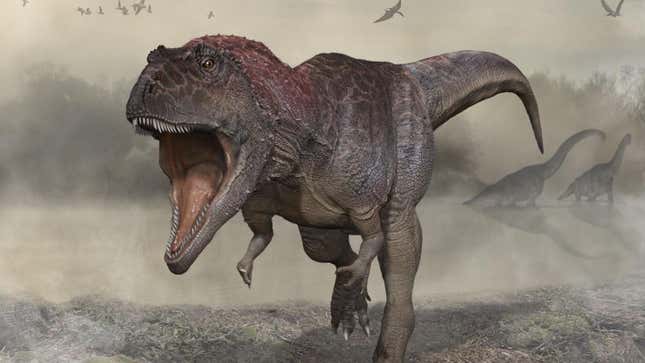
Tyrannosaurus rex was one of the scariest dinosaurs to have roamed the planet, but it’s also the laughing stock of the dinosaur kingdom due its tiny arms. Never fear, T. rex: Researchers in Argentina have found you a friend that shares your absurdly small arms.
Meraxes gigas is a carnivorous dinosaur whose bones were unearthed and studied by scientists in Argentina over the past decade. Their research began in 2012, when fossils of an unknown species appeared at a dig site in Argentina. They sorted the specimen into a group of theropods known as Carcharodontosauridae, but after closer inspection, they were stumped as to what species it could be. This uncertainty eventually led them to classify the animal as something new. They named it “gigas” for its massive size (an estimated 11 meters (36 feet) long and approximately 4 tons) and “Meraxes” after a dragon from George R.R. Martin’s fantasy novel series A Song of Ice and Fire.
The creature’s small arms certainly stood out, but the reason why these dinosaurs have them is still a mystery.
“The function of those tiny arms is very, very difficult to know. We need a time machine,” said Juan Ignacio Canale in a video call with Gizmodo. Canale is a paleontologist with the National Scientific and Technical Research Council in Buenos Aires and lead author of the new paper published today in Current Biology. “The authors of the paper agree that these short arms have some sort of function. It’s very unlikely that those arms were useless.”
The researchers believe the arms had a function because M. gigas had very large scapulae, which points to it having had strong arm muscles, once upon a time. Smaller arms might have helped the dinosaur up from a prone position, allowed them to hold onto a mate during reproduction, or kept dinosaurs from mutilating each other when a group was feeding together on a carcass. But what’s fascinating is that these small arms are present in unrelated groups of predators.
Canale and his colleagues compared the presence of tiny arms between three groups of dinosaurs—the tyrannosaurids, abelisaurids, and carcharodontosaurids—and found that each one evolved short forelimbs independently.
“What’s remarkable is that these short-armed dinosaurs are distantly relatives on the dinosaur family tree. This means that diminutive arms evolved multiple times in different groups of giant carnivorous dinosaurs,” said Akinobu Watanabe, a paleontologist unaffiliated with this research, via email. Watanabe is an associate professor of anatomy at New York Institute of Technology and a research associate in the American Museum of Natural History’s Division of Paleontology.
Watanabe suspects that the small size of the M. gigas’ arms could be a result of evolution favoring a large head and powerful jaw, features that were potentially more effective tools for hunting.
Steve Brusatte, a paleontologist from the University of Edinburgh, echoed Watanabe’s theory. “Tiny arms were a normal thing for huge [carnivores],” Brusatte said to Gizmodo in an email. “It’s still not clear why, but I suspect it is because the heads of these monsters became so big and strong that they took care of almost everything when it came to eating: grabbing and killing and slicing and devouring the prey.” Brusatte was unaffiliated with the new research but was a peer reviewer on the paper.

Canale and his colleagues found M. gigas at a field site about 10 kilometers (6.2 miles) from El Chocon, Argentina, an area in Northern Patagonia that’s typically very cold and dry with little vegetation, but M. gigas went extinct at the beginning of the Late Cretaceous—somewhere in the ballpark of 90 million to 95 million years ago. At that time, the world looked completely different. This part of Earth was hot, humid, and lush, and the area shared biodiversity with Africa, says Canale: “South America was pretty close, or even in contact with Africa. The Atlantic Ocean was starting to be formed.”
The initial dig happened in 2012, after Canale and a colleague found a small fragment of a sauropod five years earlier during an exploratory visit to the field site, with more fossils located under about 2 meters (6.5 feet) of sandstone. Three grueling, month-long field trips and some jackhammering later, the researchers were able to exhume the fossils and begin processing them. But Canale says the study of this new specimen is just beginning. “We have a lot more to work on. We have to do the detailed descriptions, we have to do a CT scan of the skull to see the internal spaces. So it’s a lot more to do still.”